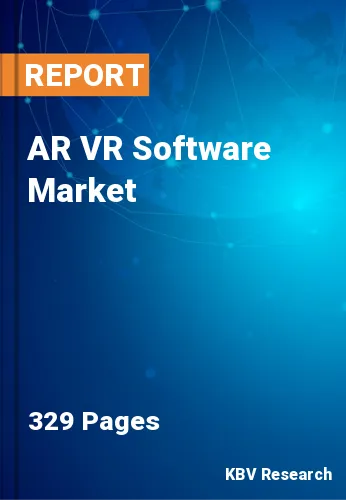
The Global AR VR Software Market size is expected to reach $97.3 billion by 2030, rising at a market growth of 18.1% CAGR during the forecast period.
AR and VR modeling and visualization software enable users to visualize 3D models and designs in a more immersive and interactive manner. This allows for a deeper understanding of complex concepts, such as architectural plans, product designs, or scientific data. Consequently, Modeling & Visualization Software segment procured $3,888.5 million revenue in the market in 2022. Designers, architects, and engineers can make real-time changes and adjustments to their models within the virtual environment. This iterative process can lead to more efficient and optimized designs. Users can simulate and test scenarios within the virtual environment. This is beneficial for understanding how designs or structures will perform under different conditions, potentially reducing costly real-world testing.
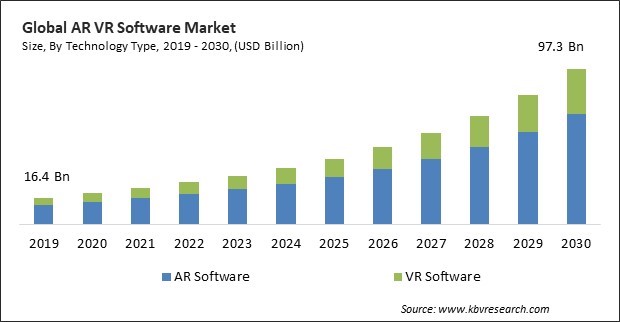
The major strategies followed by the market participants are Partnerships, Collaborations & Agreements as the key developmental strategy to keep pace with the changing demands of end users. For instance, In August, 2023, Magic Leap, Inc. joined hands with Microsoft Corporation and Qualcomm Technologies, Inc. Under this collaboration, the Mixed Reality Toolkit (MRTK) was introduced. The MRTK is a platform for AR/VR development framework and assists the developers in app creation. Moreover, In October, 2019, NVIDIA Corporation expanded their partnership with Red Hat, Inc for providing access to the Red Hat OpenShift and the NVIDIA EGX platform to customers. Additionally, the individuals incorporated NVIDIA GPUs to enhance data science, AI and machine learning.
Based on the Analysis presented in the KBV Cardinal matrix; Google LLC and Microsoft Corporation are the forerunner in the Market. In January, 2022, Microsoft Corporation partnered with Qualcomm Technologies, Inc., an American multinational corporation. Through this partnership, the companies broadened the use of augmented reality (AR) in the consumer as well as the enterprise sector. Companies such as Adobe, Inc., Qualcomm, Inc., NVIDIA Corporation are some of the key innovators in the Market.
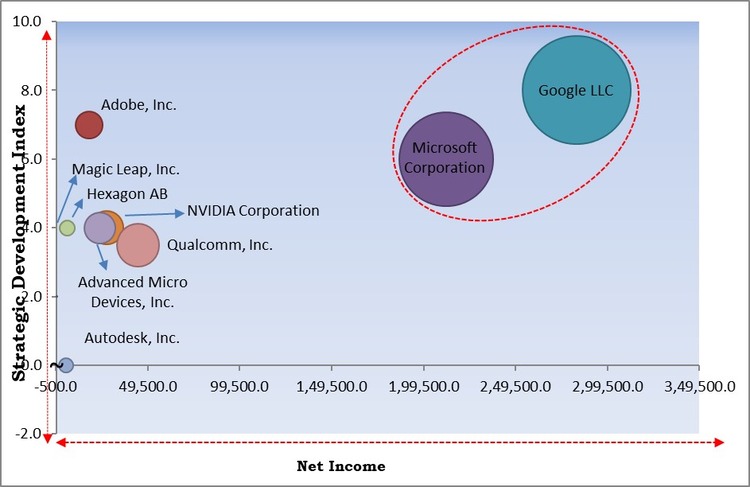
The surge in gaming's popularity has led to increased demand for AR and VR software applications in the industry. As gamers seek more immersive and interactive experiences, AR and VR technologies have proven to be a natural fit, offering an unprecedented level of immersion and engagement. This alignment has stimulated the creation of a wide array of gaming content that leverages AR and VR software, expanding the market's portfolio of offerings. Consequently, the growing popularity of gaming is not only expanding the market within the gaming industry but also contributing to its broader acceptance and utilization across diverse domains, ultimately driving market growth and technological advancement.
A significant consequence of this shift is the increased demand for AR and VR software that supports remote work and collaboration. As organizations recognize the potential of these technologies to bridge geographical gaps and facilitate seamless communication, the market has responded with a surge in applications tailored for remote work scenarios. The steady integration of these technologies in the remote work landscape not only bolsters their market presence but also promotes innovation in AR and VR software, as developers continue to refine and expand their applications to meet the evolving needs of remote work and collaboration. In conclusion, the positive impact of enhancing remote work and collaboration through AR and VR software is a catalyst for the continuous growth and diversification of the market, propelling it to new heights.
The immediate repercussions of the limitation of AR and VR content is the restraint it places on market expansion. With a restricted catalog of content, potential users and businesses may perceive AR and VR technologies as lacking the necessary depth and breadth to justify investment. Furthermore, the scarcity of content acts as a deterrent to sustained user engagement. Without a steady stream of diverse and high-quality content, users may not find compelling reasons to continue using AR and VR technologies. This can lead to a decline in user interest, reducing the market's user base and subsequently limiting its impact on various industries. Therefore, the negative impact of a limited amount of content in the market is severe, affecting its growth, adoption, and innovation potential.
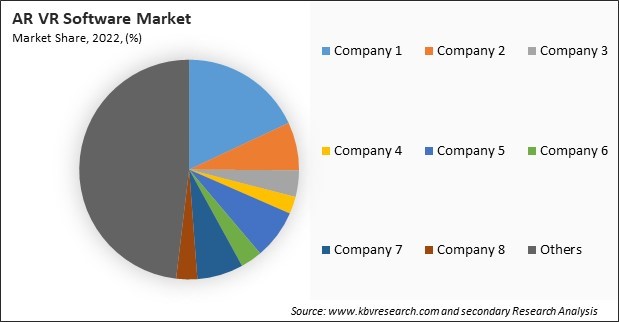
The leading players in the market are competing with diverse innovative offerings to remain competitive in the market. The above illustration shows the percentage of revenue shared by some of the leading companies in the market. The leading players of the market are adopting various strategies in order to cater demand coming from the different industries. The key developmental strategies in the market are Partnerships, Collaborations & Agreements.
On the basis of software type, the market is divided into software development kit, game engine, modeling & visualization software, content management system, training simulation software, and others. The software development kit segment acquired the largest revenue share in the market in 2022. AR and VR SDKs provide pre-built frameworks, libraries, and tools that streamline the development process. Developers can save time and effort by using these pre-existing components, allowing them to create applications more quickly. SDKs ensure consistency in AR and VR application development. They provide standardized APIs and best practices, reducing the likelihood of errors and inconsistencies in the codebase. AR and VR SDKs typically offer access to hardware-specific features and sensors, such as cameras, accelerometers, and gyroscopes, allowing developers to create more advanced and immersive experiences.
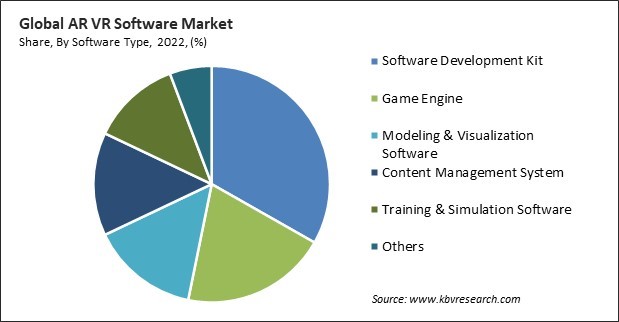
Based on technology type, the market is bifurcated into AR software and VR software. The VR software segment garnered a considerable growth rate in the market in 2022. VR software provides users with immersive and realistic experiences. Whether it's gaming, training, or virtual tours, users can feel like they are physically present in a different environment, enhancing engagement and enjoyment. In sectors like aviation and industrial manufacturing, VR training reduces the risk of accidents and equipment damage. It also minimizes the costs associated with physical training equipment and real-world simulations. VR is used in healthcare for pain management, exposure therapy, and physical rehabilitation. It can distract patients from pain, treat phobias, and aid in the recovery of motor skills.
Based on vertical, the market is categorized into media & entertainment, retail & e-commerce, training & education, travel & hospitality, aerospace & defense, real estate, manufacturing, healthcare, automotive, and others. The retail & e-commerce segment procured a remarkable growth rate in the market in 2022. Shoppers can use AR to virtually try on clothing, accessories, or cosmetics, improving the online shopping experience and reducing the rate of returns. AR apps can provide in-store navigation and location-based offers to enhance the shopping experience in physical stores. AR and VR enable customers to visualize how furniture or home decor items will look in their homes, making purchasing decisions easier. AR can provide additional information about products when scanning barcodes or using image recognition, helping customers make informed choices.
| Report Attribute | Details |
|---|---|
| Market size value in 2022 | USD 26.4 Billion |
| Market size forecast in 2030 | USD 97.3 Billion |
| Base Year | 2022 |
| Historical Period | 2019 to 2021 |
| Forecast Period | 2023 to 2030 |
| Revenue Growth Rate | CAGR of 18.1% from 2023 to 2030 |
| Number of Pages | 329 |
| Number of Table | 444 |
| Report coverage | Market Trends, Revenue Estimation and Forecast, Segmentation Analysis, Regional and Country Breakdown, Competitive Landscape, Market Share Analysis, Companies Strategic Developments, Company Profiling |
| Segments covered | Technology Type, Software Type, Vertical, Region |
| Country scope | US, Canada, Mexico, Germany, UK, France, Russia, Spain, Italy, China, Japan, India, South Korea, Singapore, Malaysia, Brazil, Argentina, UAE, Saudi Arabia, South Africa, Nigeria |
| Growth Drivers |
|
| Restraints |
|
Region-wise, the market is analyzed across North America, Europe, Asia Pacific, and LAMEA. The Asia Pacific region garnered the largest revenue share in the market in 2022. Asia Pacific has seen a significant growth in its technology ecosystem, with thriving tech hubs in countries like China, Japan, South Korea, and India. This has led to increased investment and innovation in AR and VR technologies. The region has a rapidly expanding base of smartphone users, providing a substantial user base for AR and VR applications, especially in mobile gaming and entertainment.
Free Valuable Insights: Global AR VR Software Market size to reach USD 97.3 Billion by 2030
The market research report covers the analysis of key stake holders of the market. Key companies profiled in the report include Microsoft Corporation, Google LLC, Magic Leap, Inc., Adobe, Inc., Autodesk, Inc., NVIDIA Corporation, Advanced Micro Devices, Inc., Qualcomm, Inc., Zoho Corporation Pvt. Ltd., and Hexagon AB.
By Vertical
By Technology Type
By Software Type
By Geography
This Market size is expected to reach $97.3 billion by 2030.
Growing popularity of gaming are driving the Market in coming years, however, Limited amount of content available for AR/VR restraints the growth of the Market.
Microsoft Corporation, Google LLC, Magic Leap, Inc., Adobe, Inc., Autodesk, Inc., NVIDIA Corporation, Advanced Micro Devices, Inc., Qualcomm, Inc., Zoho Corporation Pvt. Ltd., and Hexagon AB.
The expected CAGR of this Market is 18.1% from 2023 to 2030.
The AR Software segment is leading the Market by Technology Type in 2022 thereby achieving a market value of $69 Billion by 2030.
The Asia Pacific region dominated the Market by Region in 2022, and would continue to be a dominant market till 2030; thereby, achieving a market value of $35.3 Billion by 2030.
Our team of dedicated experts can provide you with attractive expansion opportunities for your business.
